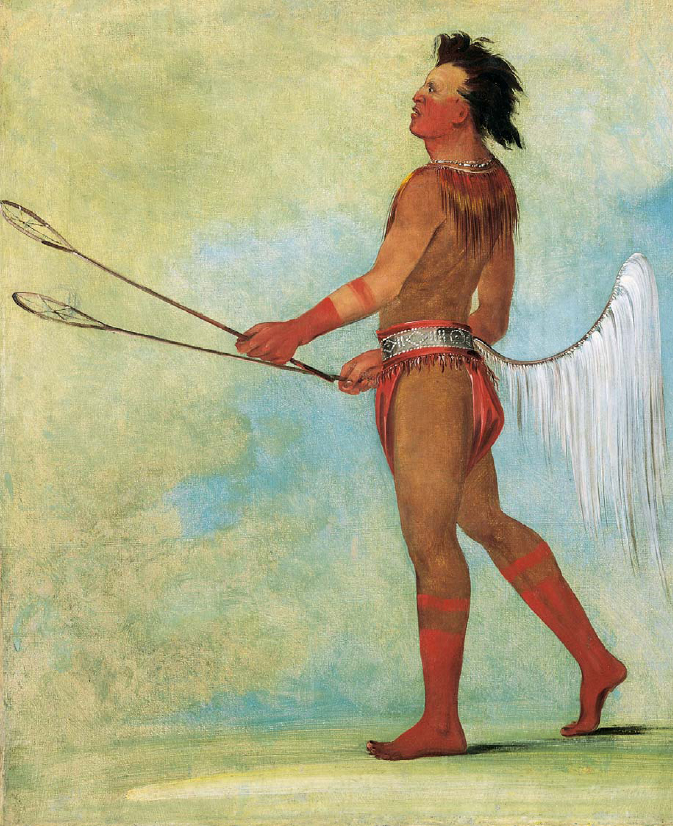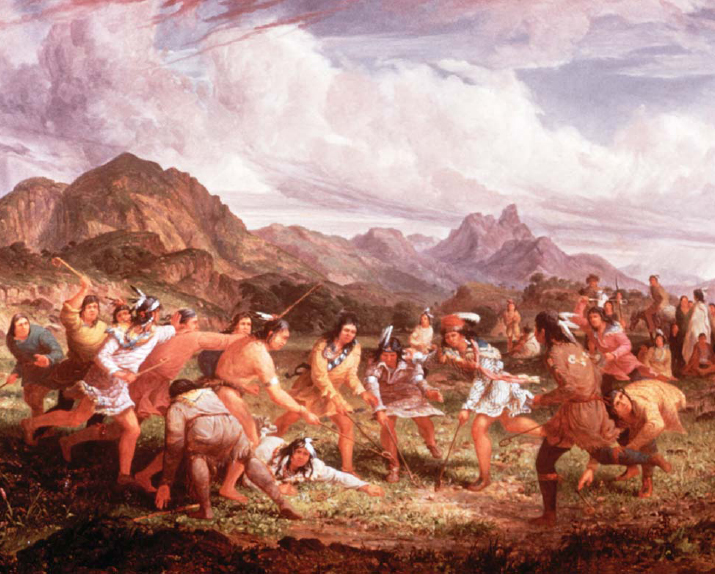
A Choctaw Indian in ballplayer’s dress, painted in 1834.
Two Penobscot Indian men gripped ropes, walking through the cold Maine countryside. The ropes were tied to a large log. They dragged the log through the snow behind them. Between their footprints, a wide path of flattened snow glistened in the sun. The men pulled the log down a steep hill and up and down a smaller one. They crossed a frozen lake, went a few yards farther, and stopped.
Back at the lodge, their sons were carving long branches. When the branches were smooth, they would be decorated to look like snakes. The snakes, thrown from the top of the hill, would slide down the track the men had just made. The air was crisp and cloudless. It was a good day to play snow snake.
Farther south, a Mandan warrior pulled back his bowstring. He pointed his arrow high into the air and let it fly. Like lightning, he grabbed another arrow and fired it. He followed that with another, and then another. His original arrow was still in the air when he fired a fifth and a sixth. He had just released his seventh arrow when his first arrow fell to the ground. He hoped seven would be enough to win the contest. Looking over at his competition, he wasn’t sure.
On the other side of the continent, a Zuñi man batted a strange object into the air. It was a shuttlecock—a bundle of cornstalks with some feathers sticking out of it. Before it touched the ground, the man hit it into the air again. A friend watched him, counting the number of times he hit it. After he reached 83, the shuttlecock hit the ground. The second man picked it up and began bouncing it off his left hand. The first player started counting. There were two blankets on the ground nearby. The first man to reach 100 hits would win them both.
Far north of them, a group of Inuit men and women stood in a circle. They gripped a wide blanket made of stitched-together sealskin. They lowered it slightly, and a young girl climbed on and stepped into the center. On a count, the group shook the blanket, tossing the girl into the air. She did a flip and landed on her feet, laughing.
Native Americans loved to play games. Men, women, and children all took part in them. Although boys and girls would often play together, it was rare for men and women to face each other in a game.
Games were played for many reasons. Some were played to cure disease. Others made the crops grow. Many games were played just for fun. Part of the fun was watching the sport and betting on the outcome.

A Choctaw Indian in ballplayer’s dress, painted in 1834.

The two competitors are neck and neck in this illustration depicting a Native American canoe race.
The Native Americans played all sorts of games. They played ball games, such as lacrosse, and guessing games. They competed in archery and spear throwing. They loved to play dice games. Many sports passed from tribe to tribe. Some were popular throughout the country; others were unique to one place. Many of these games are similar to the games we play today. §

Lacrosse, the sport for which the woodland Indians of the Northeast were best known, used a buckskin ball. Players’ rackets were made of bent saplings that had been netted with leather thongs.